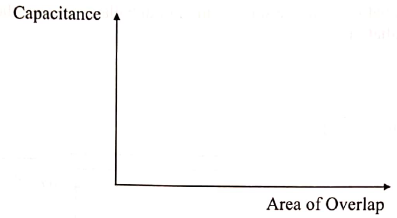SECTION A (25 marks)
Answer all the questions in this section in the spaces provided.
- Figure 1 shows two planc mirrors inclined at an angle of 120° to cach other. A ray of light makes an angle of 40° with the first mirror.
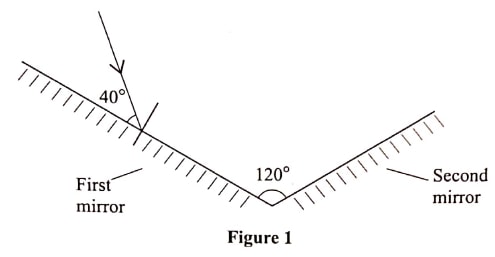
By completing the ray diagram determine the angle of reflection on the second mirror. (2 marks) - State the reason why an increase in leaf divergence is the only sure way of determining whether an object is negatively charged using a negatively charged electroscope. (1 mark)
- State two properties of magnetic field lines around a bar magnet. (2 marks)
- Figure 2 shows an incomplete circuit for an electromagnet.
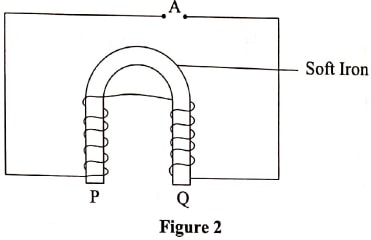
- Complete the diagram to show how a battery should be connected at A so that the polarities at P and Q are South and North respectively. (1 mark)
- State two ways in which the strength of the electromagnet in (a) can be increased. (2 marks)
- In a siren, sound is produced when a jet of air is directed perpendicular to a ring of holes on a rotating wheel. Explain the effect on the pitch of sound produced when the speed of rotation of the wheel is increased. (2 marks)
- State the reason why the current produced by a simple cell falls rapidly when the cell is being used. (1 mark)
- Figure 3 shows a cell connected in series with an ammeter, a 2Ω resistor and a switch. A voltmeter is connected across the cell
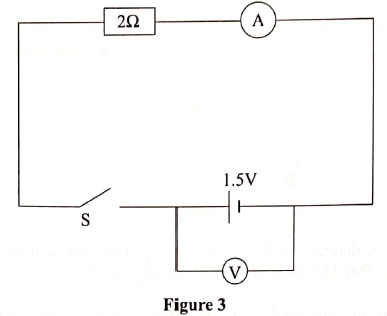
With the switch open, the voltmeter reads 1.5 V. Given that the internal resistance of the cell is 0.5 S2, determine the ammeter reading when the switch is closed. (3 marks) - State two uses of gamma rays in medicine. (2 marks)
- Figure 4 shows the input and output signals on a CRO screen when two diodes are used during a full wave rectification.
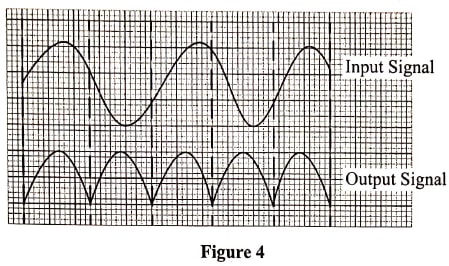
Explain how the two diodes rectify the input signal. (3 marks) - State how the intensity of X-rays in an X-ray tube can be increased (1 mark)
- Figure 5 shows part of the lighting circuit in a house.
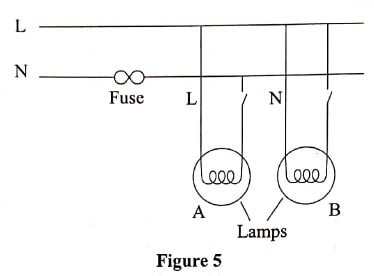
State two errors in the wiring circuit. (2 marks) - Uranium decays as shown below.
Name the particle X that is emitted during this decay. (1 mark) - State the disadvantage of using a convex mirror as a driving mirror. (1 mark)
- Figure 6 shows radiation from the sun passing through glass in a greenhouse onto the floor. The floor then emits radiation.
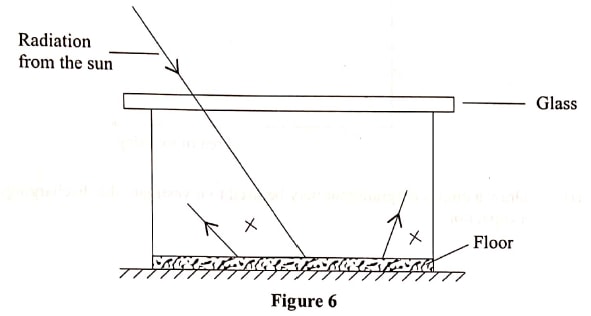
State the name of the radiation emitted by the floor. (1 mark)
SECTION B (55 marks)
Answer all the questions in this section in the spaces provided.
-
- On the axes provided, sketch a graph of capacitance against the area of overlap of the plates of a parallel-plate capacitor. (1 mark)
-
- Draw a circuit diagram that may be used to investigate the discharging process of a capacitor. (2 marks)
- On the axes provided sketch the graph of potential difference between the plates against time for the discharging process. (1 mark)
- Figure 7 shows three capacitors connected to a 6V battery.
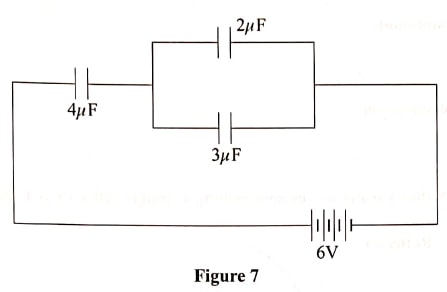
Determine the:- effective capacitance (3 marks)
- total charge stored (2 marks)
- potential difference across the 4uF capacitor (2 marks)
- On the axes provided, sketch a graph of capacitance against the area of overlap of the plates of a parallel-plate capacitor. (1 mark)
-
- Define the following terms as used in waves:
- Amplitude (1 mark)
- Wavelength (1 mark
- Figure 8 show's water waves approaching a straight reflector at a speed of 40 cms-1.
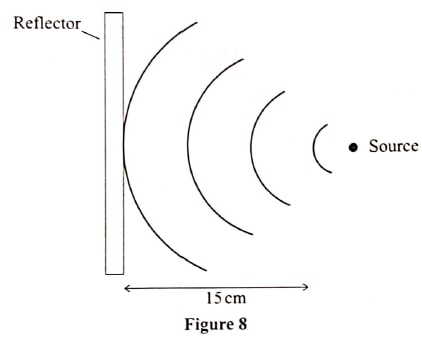
- Draw on the diagram the reflected waves. (3 marks)
- Given that the distance between the source and the reflector is 15 cm determine:
- the wavelength of the waves (2 marks)
- the frequency of the waves (2 marks)
- Figure 9 shows light rays from two coherent sources S1 and S2 falling on a screen. Dark and bright fringes are observed between A and B.
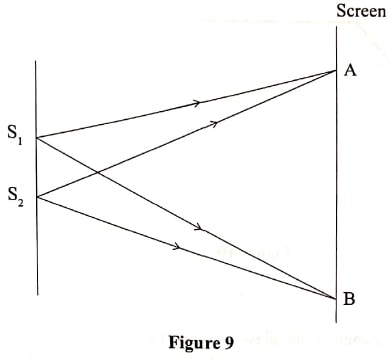
- State how:
- bright fringes are formed (1 mark)
- dark fringes are formed (1 mark)
- State what is observed when light of a higher frequency is used. (1 mark)
- State how:
- Define the following terms as used in waves:
-
- Figure 10 shows a ray of light travelling from glass to air.
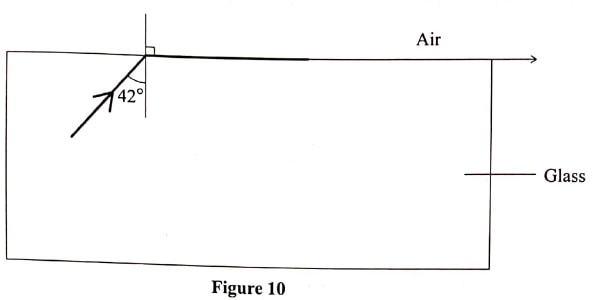
Determine the:- critical angle of the glass - air interface (1 mark)
- refractive index of glass (2 marks)
- A piece of metal is embedded at the centre of an ice block 15 cm from the surface of the ice. Given that the refractive index of ice is 1.32, determine how far from the surface of the ice block the metal appears to be. (3 marks)
- Figure 11 shows two rays of incident on a diverging lens.
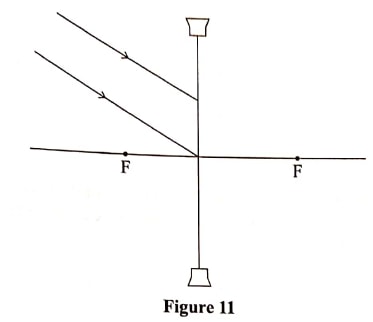
Complete the ray diagram to show the path of the rays after passing through the lens. (2 marks) -
- State two differences between the human eye and a camera lens. (2 marks)
- State the name of the part of the eye that enable the lens to focus images of objects at different distances. (1 mark)
- Figure 10 shows a ray of light travelling from glass to air.
-
- Describe how a magnet can be demagnetised using the electrical method. (2 marks)
- You are provided with two iron bars P and Q. One of the bars is magnetised while the other is not. Explain how the magnetised bar can be identified without using a magnet or magnetic material. (2 marks)
- Figure 12 shows two identical copper coils X and Y placed close to each other. Coil X is connected to a DC power supply while coil Y is connected to a galvanometer.
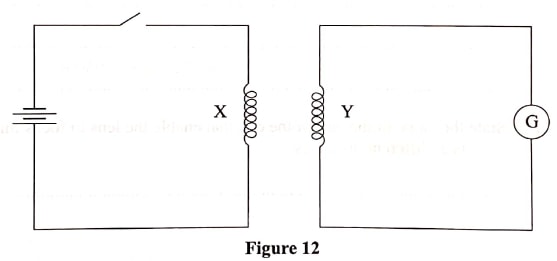
- Explain what is observed on the galvanometer when the switch is closed. (4 marks)
- State what is observed on the palvanometer when the switch is opened. (1 mark)
- State what would be observed if the number of turns in coil Y is doubled. (1 mark)
-
- Define half life as used in radioactivity.
- Figure 13 shows a device used to detect radioactivity by forming tracks when air is ionised.
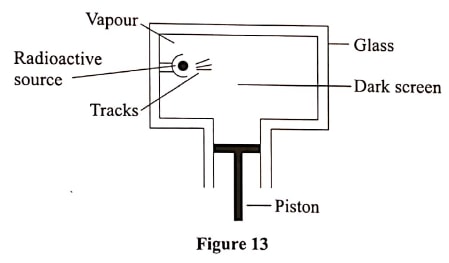
- State the name of the device shown. (1 mark)
- State how air in the device gets ionised. (1 mark)
- Describe how tracks are formed. (3 marks)
-
- State two factors that determine the speed of the photoelectrons emitted from a metal surface. (2 marks)
- The energy of a photon of light is 2.21 eV. (electronic charge is 1.6 x 10-19C and planks constant h is 6.63 x 10-34Js)
- Express this energy in joules. (1 mark)
- Determine the frequency of the light that produces the photon. (2 marks)

Marking Scheme
SECTION A (25 marks)
Answer all the questions in this section in the spaces provided.
- Figure 1 shows two planc mirrors inclined at an angle of 120° to cach other. A ray of light makes an angle of 40° with the first mirror.
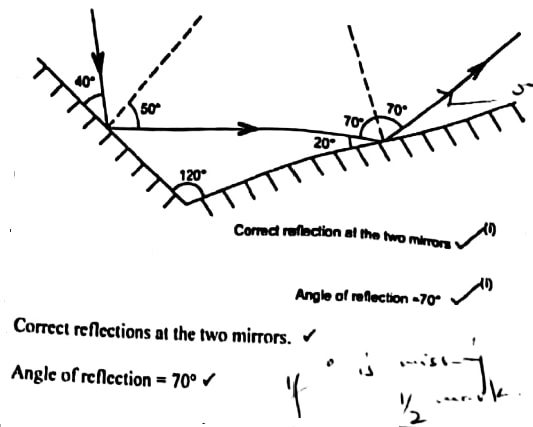
By completing the ray diagram determine the angle of reflection on the second mirror. (2 marks) - State the reason why an increase in leaf divergence is the only sure way of determining whether an object is negatively charged using a negatively charged electroscope. (1 mark)
- An uncharged body will also cause a decrease in the divergence of the leaf
or - Both posituvely charged body and an uncharged body cause a decrease in divergence
- An uncharged body will also cause a decrease in the divergence of the leaf
- State two properties of magnetic field lines around a bar magnet. (2 marks)
- Do not cross each other
- They are complete loops
- Direction of the field is from North to South
- They are norma to the surface at the poles
- Figure 2 shows an incomplete circuit for an electromagnet.
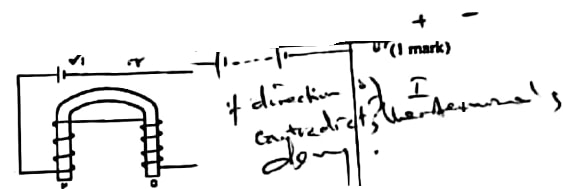
- Complete the diagram to show how a battery should be connected at A so that the polarities at P and Q are South and North respectively. (1 mark)
- State two ways in which the strength of the electromagnet in (a) can be increased. (2 marks)
- Increasing the number of turns in the coil
- Increasing the current or number of cells/p.d
- In a siren, sound is produced when a jet of air is directed perpendicular to a ring of holes on a rotating wheel. Explain the effect on the pitch of sound produced when the speed of rotation of the wheel is increased. (2 marks)
- Increasing speed increases the frequency of the sound causing an increase in the pitch (higher pitch)
- State the reason why the current produced by a simple cell falls rapidly when the cell is being used. (1 mark)
- Polarization occurs
- Figure 3 shows a cell connected in series with an ammeter, a 2Ω resistor and a switch. A voltmeter is connected across the cell
With the switch open, the voltmeter reads 1.5 V. Given that the internal resistance of the cell is 0.5 S2, determine the ammeter reading when the switch is closed. (3 marks)
- State two uses of gamma rays in medicine. (2 marks)
- To sterilize medical equipment
- to kill cancerous cells and malignant growths in the body
- Figure 4 shows the input and output signals on a CRO screen when two diodes are used during a full wave rectification.
Explain how the two diodes rectify the input signal. (3 marks)- During the first cycle of the input signal, current flows in the first diode
- During the second half cycle of the input signal, current flows in the second diode
- When the currents through the two diodes are combined, a fully rectified wave signal as the output signal
- State how the intensity of X-rays in an X-ray tube can be increased (1 mark)
- By increasing the heating current in order to produce more electrons
- Figure 5 shows part of the lighting circuit in a house.
State two errors in the wiring circuit. (2 marks)- Fuse in the neutral wire instead of the live wire
- Switch to lamp on the netral wire instead of the live wire
- Connection of lamp B on live wires ony
- Uranium decays as shown below.
Name the particle X that is emitted during this decay. (1 mark)- Alpha particle/Helium nucleus/Helium ion
- State the disadvantage of using a convex mirror as a driving mirror. (1 mark)
- Shows the object as being further than it actually is
- roduces diminished image
- Figure 6 shows radiation from the sun passing through glass in a greenhouse onto the floor. The floor then emits radiation.
State the name of the radiation emitted by the floor. (1 mark)- infrared
SECTION B (55 marks)
Answer all the questions in this section in the spaces provided.
-
- On the axes provided, sketch a graph of capacitance against the area of overlap of the plates of a parallel-plate capacitor. (1 mark)
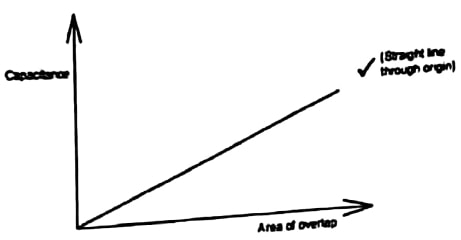
-
- Draw a circuit diagram that may be used to investigate the discharging process of a capacitor. (2 marks)
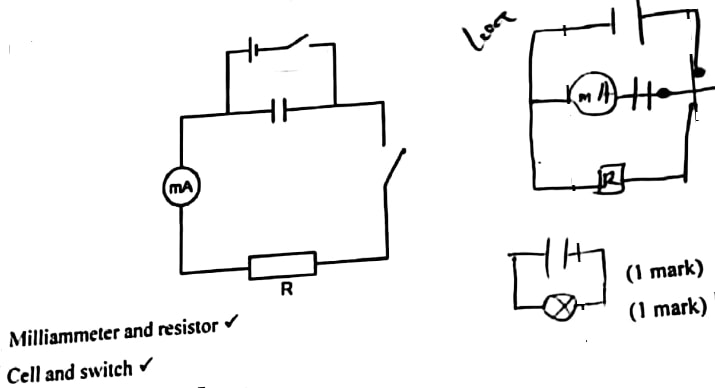
- On the axes provided sketch the graph of potential difference between the plates against time for the discharging process. (1 mark)
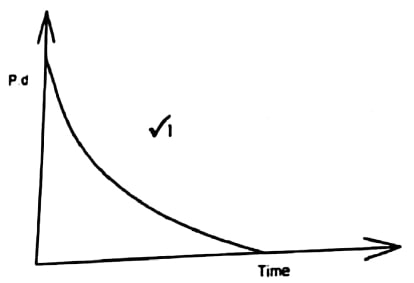
- Draw a circuit diagram that may be used to investigate the discharging process of a capacitor. (2 marks)
- Figure 7 shows three capacitors connected to a 6V battery.
Determine the:- effective capacitance (3 marks)
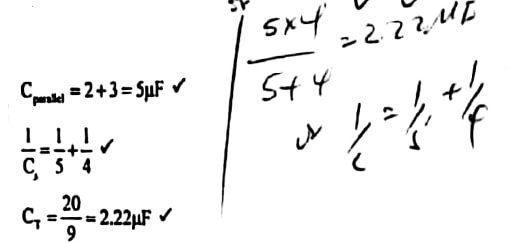
- total charge stored (2 marks)
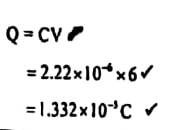
- potential difference across the 4uF capacitor (2 marks)
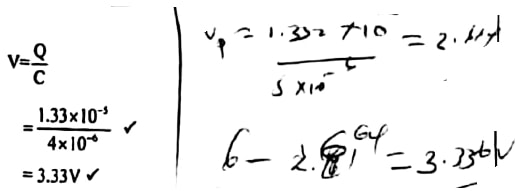
- effective capacitance (3 marks)
- On the axes provided, sketch a graph of capacitance against the area of overlap of the plates of a parallel-plate capacitor. (1 mark)
-
- Define the following terms as used in waves:
- Amplitude (1 mark)
- Amplitude is the maximum displacement from the mean position
- Wavelength (1 mark
- Wavelength is the distance between two successive points in a wave which are in phase
OR - Distance between two successive troughs or crests in a transverse wave/between successive rarefactions or compressions in a longitudinal wave
- Wavelength is the distance between two successive points in a wave which are in phase
- Amplitude (1 mark)
- Figure 8 show's water waves approaching a straight reflector at a speed of 40 cms-1.
- Draw on the diagram the reflected waves. (3 marks)
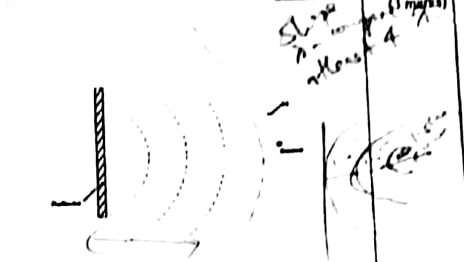
- Given that the distance between the source and the reflector is 15 cm determine:
- the wavelength of the waves (2 marks)
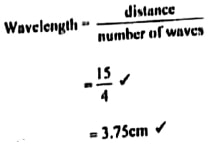
- the frequency of the waves (2 marks)
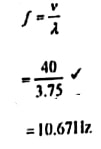
- the wavelength of the waves (2 marks)
- Draw on the diagram the reflected waves. (3 marks)
- Figure 9 shows light rays from two coherent sources S1 and S2 falling on a screen. Dark and bright fringes are observed between A and B.
- State how:
- bright fringes are formed (1 mark)
- due to constructive interference
- dark fringes are formed (1 mark)
- due to destructive interference
- bright fringes are formed (1 mark)
- State what is observed when light of a higher frequency is used. (1 mark)
- the fringes get closer
OR - when the frequency is higher the wavelength reduces hence the fringe separation decreases
- the fringes get closer
- State how:
- Define the following terms as used in waves:
-
- Figure 10 shows a ray of light travelling from glass to air.
Determine the:- critical angle of the glass - air interface (1 mark)
- Critical angle = 42o since angle of refraction is 90o
- refractive index of glass (2 marks)
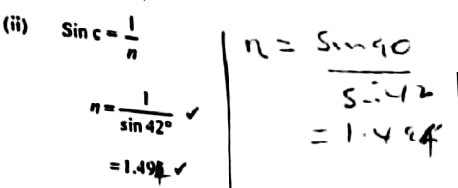
- critical angle of the glass - air interface (1 mark)
- A piece of metal is embedded at the centre of an ice block 15 cm from the surface of the ice. Given that the refractive index of ice is 1.32, determine how far from the surface of the ice block the metal appears to be. (3 marks)
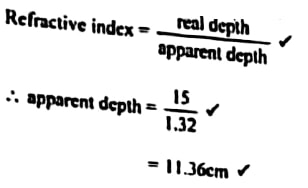
- Figure 11 shows two rays of incident on a diverging lens.
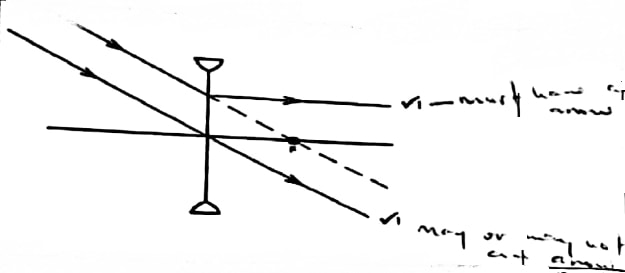
Complete the ray diagram to show the path of the rays after passing through the lens. (2 marks) -
- State two differences between the human eye and a camera lens. (2 marks)
- eye has a variable focal length while the focal length of the camera lens is fixed
- Image distance from the lens is almost constant in the eye while in the camera it can be varied
- Eye views multiple images while the camera takes only one photograph at a time
- Eye lens is muscular while the camera lens is gass/clear/plastic
- State the name of the part of the eye that enable the lens to focus images of objects at different distances. (1 mark)
- ciliary muscles
- State two differences between the human eye and a camera lens. (2 marks)
- Figure 10 shows a ray of light travelling from glass to air.
-
- Describe how a magnet can be demagnetised using the electrical method. (2 marks)
- Place the bar magnet inside a solenoid placed in an East West direction then pass an alternating current through the solenoid
- withdraw the magnet from the solenoid while there is still passing of the current
- You are provided with two iron bars P and Q. One of the bars is magnetised while the other is not. Explain how the magnetised bar can be identified without using a magnet or magnetic material. (2 marks)
- Suspend each of the bars through its centre of gravity and set it swinging in a horizontal plane through a vertical axis through its centre
- The magnetized bar will always come to rest in a north-south direction
- Figure 12 shows two identical copper coils X and Y placed close to each other. Coil X is connected to a DC power supply while coil Y is connected to a galvanometer.
- Explain what is observed on the galvanometer when the switch is closed. (4 marks)
- The galvanometer pointer first deflects then moves back; when the switch is closed, a current builds up in the coil X and due to change in flux linkage an emf is induced in coil Y making an induced current flow throw the galvanometer during the time current in coil X is rising. When the current through coil X is steady no induced current flows through the galavanometer since there is no change in flux linkage
- Therefore the pointer deflects back
- State what is observed on the galvanometer when the switch is opened. (1 mark)
- Pointer deflects in the oppsoite direction
- State what would be observed if the number of turns in coil Y is doubled. (1 mark)
- Magnitude of deflection increases
- Explain what is observed on the galvanometer when the switch is closed. (4 marks)
- Describe how a magnet can be demagnetised using the electrical method. (2 marks)
-
- Define half life as used in radioactivity.
- Half life is the time taken for half the number of nuclides initially present in a sample to decrease
- Figure 13 shows a device used to detect radioactivity by forming tracks when air is ionised.
- State the name of the device shown. (1 mark)
- Expansion cloud chamber
- State how air in the device gets ionised. (1 mark)
- Due to collisions between the radiations from the radiation source and the air molecules
- Describe how tracks are formed. (3 marks)
- When the piston is pulled down, air expands hence cools
- the ions form nuclei for condensation upon cooling, on which the saturated alcohol vapour condenses
- State the name of the device shown. (1 mark)
-
- State two factors that determine the speed of the photoelectrons emitted from a metal surface. (2 marks)
- the work function of the metal
- Energy of incident radiation/frequency wavelength
- The energy of a photon of light is 2.21 eV. (electronic charge is 1.6 x 10-19C and planks constant h is 6.63 x 10-34Js)
- Express this energy in joules. (1 mark)
- Energy =ev = 1.6 × 10-19 × 2.21
= 3.54 × 10-19
- Energy =ev = 1.6 × 10-19 × 2.21
- Determine the frequency of the light that produces the photon. (2 marks)
- E = hf
f = E/h
= 3.54 × 10-19
6.63 × 10-34
= 5.33 × 1014 Hz
- E = hf
- Express this energy in joules. (1 mark)
- State two factors that determine the speed of the photoelectrons emitted from a metal surface. (2 marks)
- Define half life as used in radioactivity.
Download KCSE 2019 Physics Paper 2 Questions With Marking Scheme.
Tap Here to Download for 50/-
Get on WhatsApp for 50/-
Why download?
- ✔ To read offline at any time.
- ✔ To Print at your convenience
- ✔ Share Easily with Friends / Students

